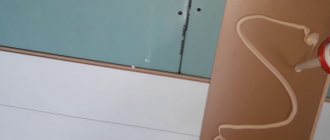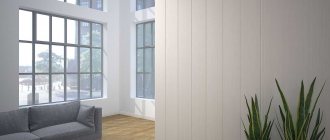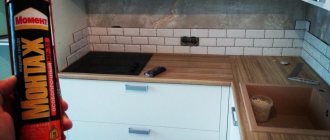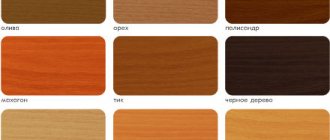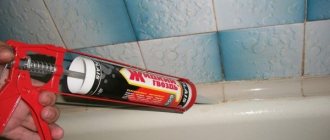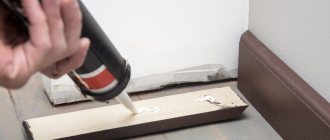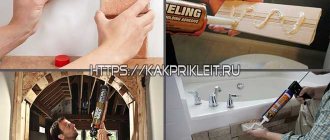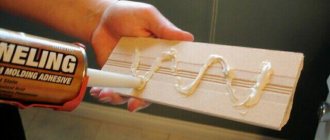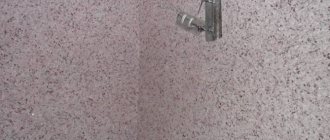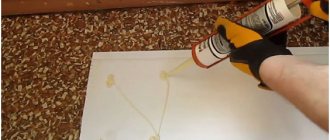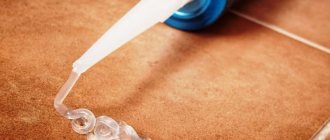When carrying out construction and repairs, there is a need for gluing surfaces on which a large load is concentrated. The degree of responsibility for the strength of the connection is too great for conventional means to be used.
Compositions, collectively called “liquid nails,” can provide the desired result, provided that the performers know how to use them and strictly follow the manufacturers’ recommendations.
No. 1. Composition of liquid nails
Liquid nails were invented in the USA. There, in the 60s, Macco first decided to package regular glue in individual cartridges for ease of use. A couple of years later, a new development appeared - Liquid Nails . In just a few years, liquid nails have conquered American users with a host of advantages, but they only entered the domestic market in the 90s.
The basis for the new type of glue was synthetic rubber with polymer additives . A special type of clay was used as a filler . In the USA, huge deposits of this clay are concentrated in the state of Texas, where the main industrial facilities of most local manufacturers are located. Today, instead of unique clay, ordinary chalk is often used. In this way, manufacturers kill two birds with one stone: on the one hand, chalk acts as a filler, but at the same time it gives the glue the necessary white color, which is achieved using classical technology by adding titanium oxide. Glue with the addition of chalk is significantly inferior in terms of quality.
Previously, toluene was added to liquid nails to improve adhesion and acetone to speed up drying. The increased toxicity of these substances forced them to abandon their use. However, some companies still use similar additives to reduce the cost of the composition. Their adhesives have an unpleasant odor and, as a rule, a suspiciously low price. Under no circumstances should such compositions be used indoors.
No. 2. Liquid nails: advantages and disadvantages
The unique composition and convenient form of packaging allows us to talk about the numerous advantages of liquid nails:
- highest connection strength. The composition can withstand loads of up to 80 kg/cm2;
- good adhesion to almost all existing materials;
- ease of use;
- the composition can be used for gluing not only smooth surfaces, but also when materials do not adhere tightly. Liquid nails simplify installation on curved surfaces;
- such glue does not destroy the surface or damage its integrity, unlike ordinary nails;
- liquid nails are not subject to corrosion;
- the installation process takes place without noise, knocking, dust and dirt;
- the glue sets in a matter of seconds;
- modern formulations are non-toxic. A rare exception is dubious products from nameless companies at unreasonably low prices;
- high fire resistance. Moisture resistance and frost resistance are characteristic only of neoprene compounds, weakly expressed in water-based adhesives;
- most formulations have a mild, almost neutral odor;
- economical consumption. One drop of material can withstand a load of up to 50 kg.
disadvantages to liquid nails, if you do not take into account some restrictions on the use of different types of glue.
How to remove liquid nails from plastic?
To remove fresh traces of liquid nails from the plastic base, it is recommended to use a rag and water. An alternative option is an oil composition (vaseline, vegetable and animal fats). Experts do not recommend using aggressive compounds or mechanical methods.
Frozen nails are removed from plastic using special removers. Before carrying out the procedure, it is worth studying the information for which surfaces the product is suitable.
Unlike other surfaces from which liquid nails are removed, plastic requires a more delicate approach. The material may be damaged when exposed to organic agents. Before using them, you need to test them: apply a drop of remover to the corner of the plastic base. If after 10-15 minutes there are no signs of deformation and no sticky layer forms on the surface, the liquid is allowed for use.
No. 3. Types of liquid nails by type of solvent
The type of solvent used actually determines the scope of application of the composition. Today the following types of liquid nails are produced:
- on a synthetic basis;
- water based.
Neoprene liquid nails are made from synthetic rubber . Such compounds can be used to glue fairly heavy structures, incl. and metal. The glue perfectly withstands high humidity, temperature changes, frost, and provides high speed and strength of setting. The downside of the material is a pungent odor and slight toxicity. When working with glue, it is necessary to provide protection for hands and respiratory organs, and to ventilate the room well. The unpleasant odor will persist for about two days after the work is completed. There is one more limitation - it is not recommended to glue synthetic materials with this composition.
Water-based acrylic liquid nails are absolutely non-toxic and practically odorless. Their strength is somewhat lower, so they are used for fastening lighter materials. It is this composition that must be used when working with porous surfaces. The disadvantages include sensitivity to temperature changes, low frost and moisture resistance, so such compositions are not suitable for large-scale work in the kitchen and bathroom.
Criterias of choice
It is difficult to choose the most suitable material from a wide range. Therefore, experts advise focusing on the criteria that determine the desired type of liquid nails.
| Manufacturer | High-quality products can be purchased from well-known manufacturers who consider the issue of reputation a priority. Among them: Moment, Kraftool, Bison, STAYER, Grover. |
| What are there | Depending on the type of solvent, the product is produced: acrylic and neoprene. Acrylic – practically odorless. Suitable for fixing lightweight materials. The purpose of the product is gluing porous surfaces. The disadvantage is considered to be low resistance to adverse conditions (temperature changes, humidity, frost). Neoprene - the composition is based on synthetic rubber. The glue can even hold metal parts together. It is characterized by increased strength of connections and resistance to adverse conditions. It takes a few minutes for the materials to adhere. The downside is the pungent odor and the presence of toxic substances in the composition. |
| Mounting adhesive base |
|
| Package | Liquid nails are packaged in two types of packaging: cartridge, tube. |
| Volume, l/weight, g | When calculating the amount of liquid nails, it is important to take into account the material consumption. This parameter can be displayed in liters or grams. The values are not equivalent. Product release options in volumes – 0.125-0.5 l; by weight – 125-440 g. |
| For external/internal work | The adhesive packaging contains information indicating the scope of application. The compositions can be intended for interior or exterior use. There are also universal liquid nails that are suitable for installation indoors and outdoors. Compositions based on synthetic rubber and resins are suitable for outdoor work. The water-soluble product is not highly resistant to atmospheric conditions. |
| Purpose |
|
| Frost resistance | This indicator is characteristic only of neoprene products. Universal compositions can withstand operation at temperatures from -20° to +80°. The installation indicator should be within 10°. Special adhesives can be used at temperatures from -12° to +35° with performance indicators during operation from -40° to +70°. |
| Water resistance | The product, which contains waterproof components, is intended for use in areas with high humidity or for outdoor work. |
| Color | Color does not determine the purpose of the product. The glue is produced transparent/translucent and in the following tones: white, beige, brown, yellow. |
No. 4. Types of liquid nails by purpose
According to their purpose, liquid nails can be divided into the following types:
- universal;
- special purpose.
It is clear that universal adhesives can be used in any conditions and for installation on any surface. However, such universality does not always work well when the conditions are very specific.
Special-purpose formulations have clear recommendations for use. The following liquid nails can be found on sale:
- for wet and dry rooms;
- for interior and exterior work;
- for fastening heavy structures;
- compositions of increased strength and high hardening speed;
- glue for mirrors, glass and ceramics;
- adhesive for expanded polystyrene panels and others.
Which liquid nails are best to choose must be decided depending on what and where you are going to attach. On the packaging, manufacturers indicate under what conditions this or that composition can be used, and for what it is primarily suitable.
Types of mounting adhesive
Adhesive liquid nails differ depending on the formulation of the constituent components. Synthetic adhesives are used for foam concrete and aerated concrete; usually polymer additives and cement-sand filler in the form of dust are introduced into them.
The main types of liquid nails:
- on a water-dispersion basis - this type belongs to the group of environmentally friendly materials;
- based on organic components – harmful to health when used due to a suffocating odor;
- chemical anchors for strong fixation of heavy objects.
Valera
The voice of the construction guru
Ask a Question
Gypsum contact is also a type of installation adhesive. The mixture includes building alabaster and various modifiers. There are compositions for fixing ceramics and plasterboard panels. Such compositions are sold in the form of a dry powder, which is mixed with water before use. Gypsum adhesives harden more slowly and are more flexible.
On organic solvents
The compositions are classified as neoprene adhesives . The pungent odor (rubber resins) gradually disappears after hardening, but lasts about 3–5 days. Such compositions are not used for gluing foam plastic, polyvinyl chloride (PVC), since they react with the materials. There is always the designation MP on the label.
Features of organic mounting adhesives :
- are characterized by increased resistance to moisture absorption;
- easily ignite from an open flame;
- objects weighing up to 5 kg can be held on the wall in a vertical position;
- There are options for indoor and outdoor use;
- one of the surfaces to be glued must have absorbent characteristics, since curing occurs due to the evaporation of the solvent from the mass.
Glue the parts to the plane twice. The first is that the product is pressed to the surface and separated for 5 to 10 minutes to remove part of the solvent and strengthen subsequent adhesion. The second clamp forms a strong connection.
Water based
Adhesives are called acrylic or water-based nails . Such compositions are harmless to health, do not emit toxic substances, and do not have a pungent odor. Apply glue at temperatures above 0°C to avoid freezing. On the label such mixtures are designated MB.
Features of the compositions:
- do not burn in case of fire, block the spread of flame;
- Available in different colors;
- not suitable for contact with metal surfaces, as they cause corrosion;
- have a longer setting time (up to 30 minutes);
- Products weighing more than 0.5 kg require long-term fixation in the mounting position.
Water-based nails are produced in the form of a transparent assembly adhesive. They are used on porous materials, filling irregularities, grooves, and small holes. Not recommended for use in damp rooms or where the surface comes into contact with water.
Chemical anchors
Chemical anchor
They are an adhesive mass made of artificial resin , packaged in ampoules or cartridges. Used for binding wall and ceiling materials and the body of the mounting anchor. The glue, together with a plastic or metal dowel, is inserted into the drilled hole on the surface. After hardening, the composition reliably fixes it in the thickness of the wall, increasing the reliability of the installed fasteners.
The difference between a chemical anchor and other adhesives:
- increased ability to bear loads;
- reliability in operation;
- increased technical characteristics;
- does not burst the walls of the drilled hole (does not expand).
The rate of hardening ranges from 2 to 24 hours depending on the purpose. Chemical anchors are used not only for interior and exterior work in everyday life; some products are used for installation with high requirements: fastening of balcony structures, elements in bridge construction, in residential and industrial construction.
No. 5. Liquid nails: application
Liquid nails are a universal material that is suitable for working with the following materials:
- brick structures;
- drywall;
- glass, mirror and ceramics;
- wood, fiberboard, chipboard and MDF;
- polystyrene;
- plastics;
- aluminum and other metals;
- cork panels;
- baths and showers, sinks;
- door frames and window frames, siding.
Sometimes liquid nails are even used to seal cracks in walls, corner joints, countertops, and ventilation holes, although it is better, of course, to use special sealants for these purposes. It is not recommended to use liquid nails when working with damp wood, or for gluing aquariums.
Liquid nails (neoprene) with organic solvent
Organic-based liquid nail compositions boast higher efficiency. Their adhesive ability is much higher. In addition, they are able to withstand low temperatures, down to -20°C, without loss of adhesion and their original properties. This construction adhesive takes less time to set and polymerize, which allows you to work with this material more efficiently.
When applying organic liquid nails, you must be careful and follow all safety precautions. Since they contain aggressive chemical components, improper handling of the material can lead to deterioration of health: dizziness, gag reflexes, general poisoning of the body.
So, even before setting, and even after complete polymerization, the organic solvent will make itself felt. And, above all, this manifests itself in a sharp and poisonous odor. For this reason, the use of liquid nails of this type in residential premises is not recommended, but it is better to use them for technical purposes.
No. 6. What else to consider when choosing liquid nails?
When purchasing, carefully study the packaging and everything that is written on it. Pay special attention to the following things:
- glue setting time . This parameter may differ slightly in different compositions. If we are talking about installing some elements on walls or ceilings, then it is better to take quick-setting adhesives to simplify the installation process;
- compound . It is better to take glue that does not contain chalk; it can slightly deteriorate the quality of the connection. If we are talking about critical fastening or gluing heavy parts, then it is definitely better not to use a composition with chalk;
- Acetone in the composition is also not desirable;
- for the bathroom and other rooms with high humidity you should definitely take moisture-resistant composition.
Can liquid nails be used instead of sealant?
Sealant is a silicone substance designed to seal seams. Liquid nails are an adhesive that is capable of fixing heavily loaded materials together. The materials under consideration not only have different purposes, but also different structures.
Studying the technical characteristics of materials, you can find a lot in common:
- moisture resistance;
- inertness to the chemical environment;
- resistance to temperature changes (certain types of sealant).
Builders use these similarities in the decoration of bathrooms. For example, to seal the joints between the wall and the sink, it is more advisable to use transparent or white liquid nails. They will not only cope with the sealing function, but will also firmly fix the plumbing fixtures to the vertical support. Other uses for adhesive as a sealant include: grouting tiles in a bathroom, finishing a kitchen unit, a gap between a bathtub and a wall, etc.
If liquid nails partially replace the functions of a sealant, it is not recommended to use silicone instead of glue.
No. 7. Manufacturers of liquid nails
The quality of the liquid glue, its composition and compliance with what is written on the packaging directly depends on the name of the manufacturer. Fastening materials and structures is a responsible matter, so there is no need to save money here. It is better to entrust the choice to products from such manufacturers as:
- HENKEL is a German company whose products are in high demand all over the world due to their high quality. the Moment Montazh brands . There are universal compounds and adhesives for baseboards, polystyrene foam panels, super-strong adhesives for metal, wood and chipboard. Adhesive “Moment Montage Superstrong Plus” can withstand loads of up to 100 kg/cm2 ;
- KIM TEC is another German manufacturer that produces universal liquid nails, moisture-resistant compounds, as well as adhesives for decorative elements, mirrors, and especially strong adhesives;
- MACCO is an American company that became a pioneer in the industry. Its products are of high quality, and the range is constantly expanding;
- FRANKLIN Titebond brand . The compositions are characterized by increased strength and sufficient range;
- SELENA GROUP – Polish company that produces liquid nails Titanwhich offer good value for money.
Voting for the best liquid nails
Which liquid nails would you choose or recommend?
Torque Installation Universal
33.33 % ( 2 )
Titebond Multi Purpose
16.67 % ( 1 )
BISON Expert KM-100
0.00 % ( 0 )
MasterTeks
16.67 % ( 1 )
Ultima 309
0.00 % ( 0 )
Vermeister Quick Stop
0.00 % ( 0 )
Krass Mirror
0.00 % ( 0 )
Ceresit CB 100
0.00 % ( 0 )
Tytan Ceramics and stone
0.00 % ( 0 )
Quelyd Mastifix
0.00 % ( 0 )
KRAFTOOL KN-915
16.67 % ( 1 )
POINT 98
16.67 % ( 1 )
No. 8. Liquid nail gun
Working with liquid nails is very simple - even a beginner in the repair business can master it. You will only need to stock up on a suitable composition and a special gun into which the glue cartridge will be inserted. Despite the menacing name, this pistol is more reminiscent of a syringe, albeit quite bulky. The glue tube is installed in the prepared niche so that on one side it rests against the tip, and on the other against the surface for pressing. The design is very simple, installing the glue cartridge is also easy.
Guns come in frame and leaf . Frame ones are more reliable, as they allow the cartridge to be fixed more tightly.
Depending on the design features, guns can be with or without reverse action . The latter are used mostly by professionals when the volume of work is large and constant. For private construction, a reverse design is more suitable.
Technology for applying liquid nails: instructions for using a gun
Liquid nails have a viscous consistency. The product should be carefully distributed over the surface. There are several ways to apply the adhesive composition. In the first case, a special tool is used - a pistol. It ensures uniform and continuous application of the product to the surface. If you don’t have a glue gun at hand, liquid nails are squeezed out manually using improvised means.
The gun promotes accurate and uniform application of the composition
Regardless of the chosen method, there are a number of rules that must be followed to ensure a reliable and high-quality connection:
- Before gluing any material onto liquid nails, the surface must be thoroughly cleaned of dust and dirt.
- Then an adhesive composition is applied to the base. Liquid nails can be applied pointwise, in a snake or mesh pattern, or as a continuous sheet.
- The parts to be glued are given the desired position, after which they are pressed against each other with great force. The parts should be kept in this state for several minutes. The exact time depends on the type of glue and the manufacturer's recommendations.
- The parts should remain in this position until the glue has completely hardened and dried. On average this takes about 24 hours.
Important! Until the composition is completely dry, the parts to be glued cannot be moved or subjected to mechanical stress.
Tools for applying liquid nails: photos, types of guns
The gun allows you to conveniently and quickly apply liquid nails to the surface. To use this tool, no special skills are required, you just need to read the instructions.
Liquid nail guns come in pneumatic, electric and mechanical types.
The construction gun consists of the following components:
- a platform designed to hold the cartridge;
- trigger;
- handles (in some models this element has a rubber coating);
- feed rod;
- pusher disk, which is mounted on the rod;
- a locking tongue that performs a locking function.
Depending on the operating principle, liquid nail guns come in several types. There are mechanical, pneumatic and electric models on sale.
For professional use, it is better to take the electric version. Such a device will greatly facilitate the work and save time. Electric models can be connected to the network through an outlet or powered by a removable battery.
A mechanical type pistol is suitable for home use. Such a tool is cheaper than electric models and its use does not require a connection to the network or constant charging of batteries. Mechanical pistols work on the principle of a conventional syringe.
A mechanical gun is the best option for household use
According to the method of attaching a cartridge with liquid nails, mechanical guns are:
- half open;
- skeletal;
- tubular.
Helpful advice! In tubular models, the glue cartridge is attached most rigidly. To keep the liquid nail bottle more firmly in the half-open gun, it is recommended to fix it with mounting tape.
In addition, there are pistols with and without reverse action. The last option is suitable for regular use. Non-reverse guns are preferred by professionals who perform large volumes of work using this tool. For home use, you can limit yourself to a reverse design.
Applying liquid nails: how to use a gun
Despite the huge variety of types and designs of pistols, these devices function approximately the same. Before you begin, you need to carefully inspect the packaging of liquid nails. If its integrity is compromised, then such a composition should not be used. Most likely, the glue has already dried or lost its properties.
Operating the gun is quite easy, even a beginner can handle it
How to use liquid nails with a gun? There are a number of steps you should take:
- To install the tube with mounting adhesive into the tool, you need to press the gun lever, which ensures locking.
- After this, the rod together with the piston is retracted back to the stop.
- Next, you need to insert the liquid nail cartridge into the base of the construction gun.
- When the tube is installed, the locking tab returns to its original position. If everything is done correctly, the piston will fit tightly to the bottom of the cartridge.
- Then you need to place the dosing cone on the neck of the tube with glue and cut off its tip.
To start working, press the trigger several times. This must be done until the adhesive composition begins to flow from the dispenser. This completes the preparation of the tool for work. To glue parts using liquid nails, you must follow the instructions described earlier. If an adhesive composition made on the basis of an organic solvent is used, protective equipment (gloves and a mask) must be used.
If you use an electric nail gun to apply liquid nails, you need to make sure that its insulation is not damaged. After completing the installation work, you should immediately clean the tool from any remaining glue and wipe it dry.
How to wipe liquid nails off a surface: methods for removing glue
Installation work using glue must be carried out carefully and without unnecessary haste. In this case, the likelihood of the composition getting on the front surface of the material is practically eliminated. However, it is better to find out in advance how to remove liquid nails in order to avoid unpleasant consequences if this does happen.
If the composition has not yet dried, it can be easily wiped off with a damp cloth.
If glue gets on the front side of the material, you need to quickly remove it from the surface. While the mixture is still wet, it can be easily wiped off with a damp cloth or mineral solvent. Once liquid nails are completely dry, they are much more difficult to remove. Special cleaners are usually used for this. For each glue option there is a specific product. You shouldn't choose it yourself. The consultant in the store will tell you how to remove liquid nails of one type or another.
Note! The hardened composition can be removed mechanically. A scraper is used for these purposes. In this case, you need to act very carefully, otherwise you can damage the surface.
To effectively remove assembly adhesive after it has dried, it is recommended to use heat. A hair dryer is suitable for these purposes. When heated to 60 °C, the hardened glue will turn into a liquid state and will be easier to remove.
No. 9. How to glue with liquid nails?
The whole process is quite simple and does not require any special skills:
- surfaces that will be glued must be thoroughly cleaned and degreased;
- It is necessary to apply glue dotwise or in a snake if the part is heavy. A special gun is used for application;
- After application, the material is quickly applied to the surface and pressed tightly. It takes about 1-2 minutes to hold the part in the required position, then you can carefully remove your hands. At this stage, if necessary, the vertical and horizontal levels are controlled;
- The glue drying time is 12-24 hours, it all depends on the type of composition, temperature, humidity and ventilation in the room. Final polymerization occurs after about a week.
When working with organic solvent-based liquid nails, you should use gloves, or better yet, a mask to protect your respiratory tract.
How to work with the composition - the correct algorithm
Before using Moment Installation liquid nails, be sure to read the instructions for use. This will save time and perform the job with maximum accuracy. Before you begin applying the adhesive, the working surfaces must be cleaned and thoroughly degreased. As a result, the coating should be completely free of dust, grease or dirt. Surfaces must be dry. Use a special gun to apply glue. The work will go faster with it.
Method of applying liquid nails
Depending on the texture of the coating, the composition must be applied in dots or thin strips located separately from each other. Immediately after this, place the surfaces to be glued together and press firmly. If you are working with massive products, you can use a wooden or rubber mallet to fix them. However, if you use liquid nails to glue wood, it is better to do without impact tools so as not to damage the wood structure.
After gluing you will need to wait. If you are gluing wooden or plastic surfaces, they will set within 10 minutes after applying the composition. In the case of aluminum surfaces, you will have to wait more than 20 minutes. At the end, you need to remove the remaining drying glue. Acetone or any other solvent can easily cope with this.
